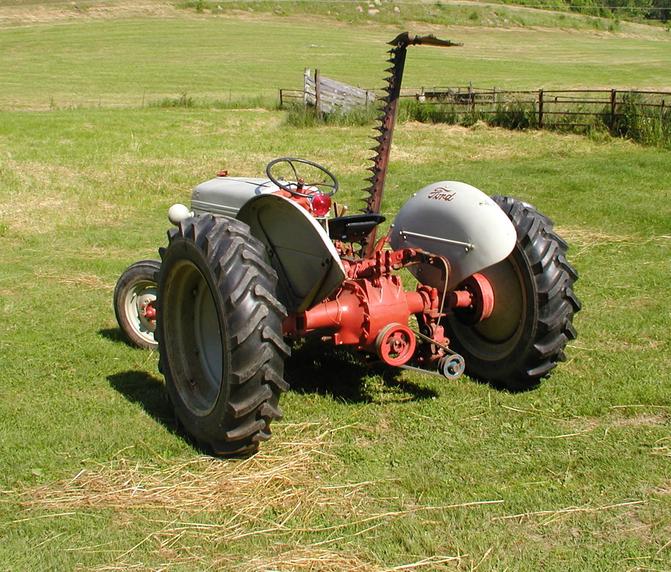
| Next Chapter | Previous Chapter | |
| Chapter 13: The Dairy Industry | Contents | Chapter 11: Machinery Changes with Time |
The first tractor mowing machine had a five and one-half foot bar. Like the old horse machines, which were four and one-half feet long, they had four "guards" per foot attached to the main bar, and four "sections" per foot attached to a second bar which shuttled back and forth through the guards. This was referred to as the "knife." The little bar to which the sections were attached with rivets in the knife was only one inch wide and perhaps one-eighth inch thick. Our final mower of this type was seven feet long. As the mower got larger, the dimensions of the sections and guards did not change. And the bar of steel which shuttled them back and forth remained one inch by one-eighth inch. There was more and more of a problem with the knife breaking.
The sections were held to the knife with two rivets. When you hit a stone, a small tree (cutting pasture) or sometimes without any visible cause, a rivet would break. Then you had to stop, withdraw the knife from the mower, put in a new section, and replace the knife in the mower. If you didn't, you left a "streak" of unmowed grass, and the drag on the machine was increased noticeably. When you turned a corner, this type of bar had to enter unmowed grass precisely at the edge of the standing grass. If it hit the ground too late, you left a patch of grass taller than the rest of the stubble which could be seen for weeks. If the bar came down too soon it went into grass previously cut lying horizontal, that fouled the bar and prevented it from cutting. This meant that you had to stop, back up, shake the bar to remove the cut grass, and then try again.
Power supplied by the tractor (or ground drive in horse mowers) is rotary and was converted into shuttle motion by a "pitman rod." It was about four feet long on horse mowers. The tractor mower came in two forms: the rear mower and the side mower. The rear mower was relatively easy to take off, but necessitated looking over your shoulder a lot, for reasons given in the last paragraph.
(Illustration 12-1)

A fully restored Ford 8N with side mower owned by Donald Byrd, who lives near Hodgesville. It is over fifty years old and "runs like new"
The "heavy duty" side mower was preferred because you didn't have to turn back to see what was going on. People swore it could be used on steeper ground, especially if the mower was on the upper side. The steepest ground was mowed by traveling in one direction, rather than around the "patch," the preferred method, and the far more time and gasoline efficient method. The side mower had a pitman only about a foot long. This meant much greater lateral forces on the knife. There was a ball on the end of the knife that fit a socket in the pitman. The part of the knife that had the ball was held to the rest of the knife by eight to ten rivets because of these lateral forces. There was an elaborate system of wear plates around the end of the knife, and it was difficult to remove the knife, to keep it adjusted so it cut well, and it had to be greased a lot. One of the worst features of the side mower was it took about half a day to take the mower off so you could plow. It was put on at the beginning of the summer and taken off at the end of it.
At one time hay crushers were popular. They consisted of two rollers of heavy steel, with the hay run between them to crush the stems, and make the hay dry out sooner. You could pull the crusher behind the mower and condition' the swath cut the previous time around. I did this for two or three years, but it was too complicated and gave it up. It was mainly helpful when the hay was heavy and we wanted to make the hay in two days.
Some people cut hay with a "brush hog" (Bush Hog was a brand name which, corrupted, became a generic name for the device), but it was never very successful. It "conditioned" the grass but a lot of the volume was lost and it didn't cut close to the ground. This style of mowing hay lasted about a decade but is still used to good effect on pastures where it is too rough for a hay mower.
We tried a "Rotary Scythe." It was a trailing mower, that is, it ran on wheels behind and to the right of the tractor. There was a horizontal, eight or nine inch diameter revolving cylinder seven feet long that carried blades four inches wide, shaped like a very shallow backwards C in cross section. These caught the grass with the lower edge of the C, cut it off, and threw it against the top shield. From there it dropped to the ground behind the machine. It was excellent at conditioning, very fast, and it could mow right through a concrete block without stopping. It seldom or never needed sharpening. We had one, and Ray Smith, our neighbor, had one. The problem was the power requirement. Even with cheap fuel it cost too much to mow with. The end of the Rotary Scythe occurred when we sold timber to Exel Bartlett.
(Illustration 12-2)
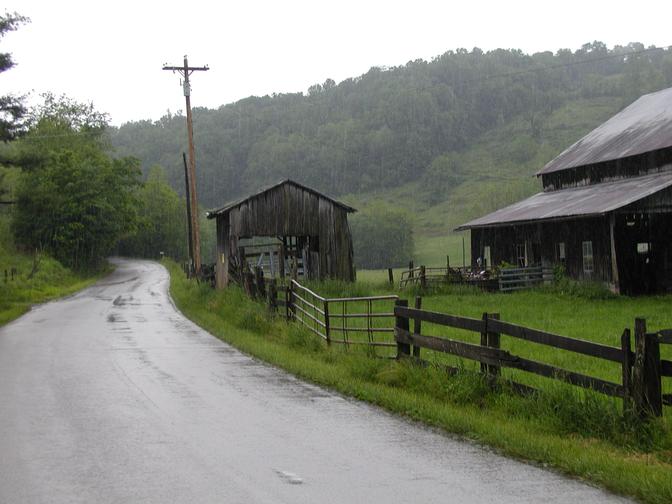
Scales house last used by Lewis Swisher on his farm between Lost Creek and Rockford
Exel was an older man, well beyond the age he should have been working in a tough business like timber harvest. He was a devout Christian of the fundamentalist sort, a deacon, and was anxious to tell you about the time a tree pinned him to the back of this bulldozer, but not quite tight enough to kill him. He gave God the credit for preventing his death, of course. I believe he was helping Eddie, his son who worked with him. I think he was afraid Eddie could not take care of himself after he (Exel) died. I haven't talked to Ed for years, but I know where he lives, go by it occasionally, and he seems OK.
Sometime in the 1970's I agreed to let Exel cut a little very choice timber in the little cove at the Southeast corner of the farm. He used a John Deere 450 dozer and a wire line (cable) about 7/8 inch diameter to move the logs. Next time I mowed the field they crossed to get the timber, the cable wound into the rotary mower. That did stop the invincible mower! It took a half-day to get it out and the mower was ruined. I never got paid for the timber, even though I followed it for a year. Exel needed the money, I suppose, and he was doing a good deed. I resented the fact that he took a white oak which had 240 rings in its stump and must have been over 60 feet tall.
Later there were two types of mowers widely used. One was a "drum mower" with gears over head and two large discs with four blades parallel to the ground. Each of the cutting discs ran on a supporting slightly convex disc on the ground which was connected to the machine above by a pivot at the center. These support discs turned one way or the other depending on where they were in contact with the ground. These mowers were very fast, but also very heavy on the rear of the tractor, because they had to be made strong.
The other type was called a "disc mower" because it had a series of discs (which were not necessarily round, but could be bars or triangles) about a foot in diameter with two, three or four blades on each. These rotated over a bar which contained a series of gears which turned the discs.
I bought a drum mower first, because it was sold by Joalde Tractor Sales, the dealer for the John Deere 2640 we got from Ray Smith when my partner, Ward Maxson, bought his farm. It was a good mower, but the drum mowers weren't as popular, and I only owned one of them before buying a disc mower from Gary Arbogast, who ran B&G Salvage, about a mile further up Jesse Run.
Aside Joe Mullooly was up some time ago to pick up some animals I wanted to go to the sale, and he happened to remark that he, his father and his uncle Tom helped load out the last shipment of cattle through the pens on the Baltimore and Ohio Railroad at Lost Creek. Joe's family has been in the cattle business in and around Lewis County "since the beginning of time." His father and later he himself, were once part owners of the sale at Deanville, a town now grown together with Weston.
The cattle shipment point at Lost Creek was very important economically. At one time it was the largest shipping point on the B & O between St. Louis and Baltimore. Driving past on the Interstate it is hard to believe this sleepy little residential town ever had great economic significance. But it has, once in the cattle business, and later as a major shipping point for coal. The cattle pens were just off to the right not far from the creek itself, as you drive south on I-79.
That last carload of cattle went through the pens about fifty years ago, around 1952, Joe remembers. He, his dad, Joe Senior, and his uncle, Tom Mullooly, got them there at dark. They had to use flashlights to finish up. The pens were already dilapidated, and having animals escape into the dark was a major worry. It was a job he had helped with many times before, since he was a kid. The cattle were from Johnstown, perhaps from the Post farm, and they were mostly Herefords, 12 to 13 hundredweight.
Joe remembers his dad had a bar of the type used to inch railroad cars along the track, which he carried around in his pickup. One man had to climb up the ladder to the top of the car where he could turn the wheel to control the brakes, and one would inch the car along so the door would line up with the loading chute. As a smaller kid Joe had climbed up on top the enclosed car, partly because he liked the ride, and partly because his Dad put him there to be out of the way.
(Illustration 12-3)
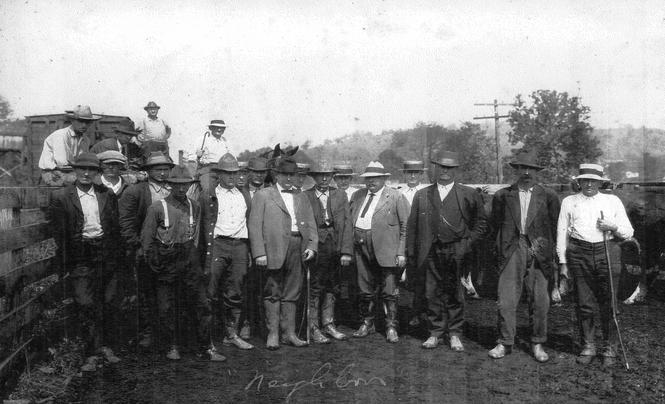
Cattlemen at Lost Creek pens 1930. On fence: Jesse Stout, Roy Davis, Gary Lawson, Alvin Bassel. Left to right in front: Fletcher Quickle, Lewis Blake, Mr. Dennison, H. Moyer, Robert Blake, Ray Boyles, Ross Lewis, Governor Gore - State of West Virginia, Carl Thrash, John Lewis, Floyd Hanifan, Charles Post, Clay Post, William Blake, Ed Cooper, Morley Watson.
Buyers went through the countryside and bought the cattle. They would write two identical notes, one for he farmer and one for the buyer, stating the price and the date the cattle were to be picked up. Both would sign each note and shake hands. That was it, no lawyer, no insurance, just each man's solemn word.
Moving the cattle was the buyer's responsibility. The cattle were often weighed on the farm (Illustration 12-2,above), even after truck transportation arrived. The buyer could get a railroad car sent to the siding where he wanted to ship, by going to the station, or after the telephone came in, simply by calling the B & O Railroad which ran through Lost Creek.
(Illustration 12-4)
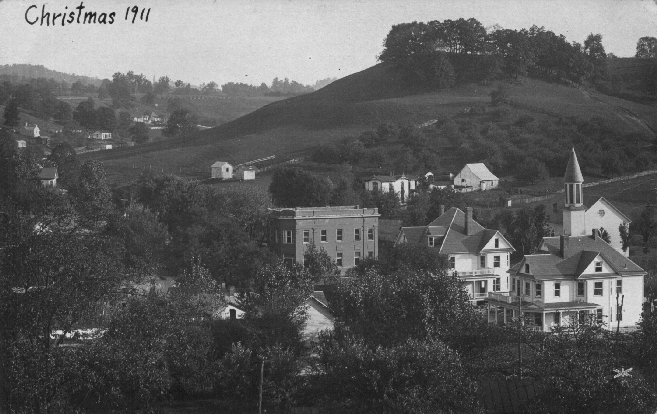
This picture of the new town of Lost Creek was used by Rev. M. G. Stillman of the Lost Creek SDB Church as a Christmas card in 1911, presumably taken in the summer of 1911. Rev. Stillman was an avid photographer and several of the pictures dating to this time in this book were taken by him. Notice the Methodist Church and the barn and hillside behind it and compare with the next picture below which was also taken by Rev. Stillman.
Early on, there were no cattle sales over the countryside as there are now; these developed after trucks came in vogue. The one in Deanville was started in 1932 by Homer Beeghley. Before that and for some time after, cattle were driven by men and boys for very considerable distances. Some came to Lost Creek from as far away as Peel Tree in Barbour County, some from Gilmer County in the South and some from Doddridge County in the West. Roanoke and Jane Lew each had a shipping point, but both went out first. There was a shipping point in Bridgeport, so the range served by Lost Creek wasn't as extensive to the North. Sometimes, though, cattle were taken to Bridgeport, Joe tells me,
(Illustration 12-5)
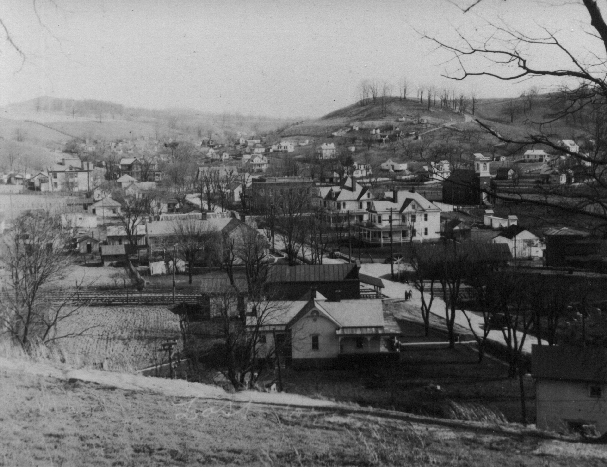
This picture was taken a few years later. Notice the old wood frame Methodist Church has been replaced by the present brick structure. The barn behind it is still there, but the orchard and pasture have been converted into a subdivision. The building partly shown in the lower right corner is Holbert's Store, the same Holbert that once owned what is now the Eastern half of our farm. On up the street, adjacent to the railroad track, near the center, is Bill Horner's Store, where I heard the story "Proved she was a man," the aside after Chapter 52. Beyond it also on the left is the Hotel. By this time the "Station" was being dropped form the original name "Lost Creek Station." Jane Lew, Rockford, West Milford an other surrounding towns are older, because Lost Creek, the town, came into existence after the railroad was built in 1887. Thanks to Patty Smith for these three pictures.
because they were on the main line, and had the best connections. If you got them there by noon, they would always be in Baltimore by 6 o'clock in the evening. If you shipped from points on a branch line, they would sometimes be shunted onto a sidetrack where they might stand for several days, loosing weight (and value).
| Next Chapter | Previous Chapter | |
| Chapter 13: The Dairy Industry | Contents | Chapter 11: Machinery Changes with Time |
Copyright © 1998, 2006, 2008, 2011 S. Tom Bond (stombond at hughes.net)